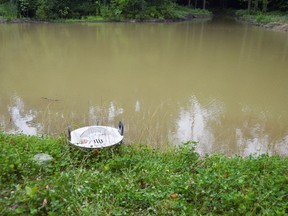Farm industry has big role in Lake Erie’s survival: Environmentalist

In 2018, faced with a rise in toxic algal blooms that threatened the health of Lake Erie, Ottawa and Queen’s Park released the Canada-Ontario Lake Erie Action Plan, pledging to reduce levels of phosphorus in the lake by 40 per cent within seven years.
Since then, says Michelle Woodhouse, water program manager with Environmental Defence, little has happened.
“We were supposed to receive an update from the province in 2020 about how we were doing so far. We never received one,” Woodhouse said, noting a new “interim update” on efforts to slow nutrient runoff into the lake has been promised for next year.
“You have multiple scientists who work on this issue on both sides of the border saying not enough is being done,” she said. “It is a challenge to know what’s going on and not see the level of urgency on behalf of our elected officials.”
Woodhouse said excess nutrients in the water and rising water temperatures due to climate change are the main reasons toxic algal blooms have proliferated on Lake Erie in the past decade, depleting oxygen and creating “dead zones” unfit for fish and other marine life.
Some nutrients leach in from urban wastewater systems overwhelmed by heavy rains, but farms are the main source of the phosphorus choking the lake.
“On both sides of the border, the main contributor is coming from agricultural runoff,” Woodhouse said.
Manure and commercial fertilizer applied to farm fields often washes off during rainfall, ending up in rivers that feed the lake. Manure pits can also jump their banks, flooding nearby waterways with nutrient-rich effluent.
“Whether it’s animal waste or human waste, that’s the issue,” Woodhouse said.
With the lake already hampered by shoreline erosion and wetland loss, Woodhouse spoke of “dire impacts” should the problem not be addressed.
“What’s going on with Lake Erie, it’s reaching a tipping point, and we are sleepwalking towards disaster,” she said.
Environmental Defense and other agencies held the sixth annual #WeAreLakeErie Day on August 31, inviting residents to post about Lake Erie on social media and “make visible how much this lake matters to so many of us (and) how precious and valuable it is, ”Woodhouse said.
“We just want to see a huge virtual wave of support for Lake Erie.”
She said the risk of inaction on algal blooms needs to be better appreciated.
“Essentially, the lake will suffocate. It will become so overloaded with nutrient pollution that it won’t be able to sustain life within in,” she said.
“You’re talking about entire food webs being impacted within the most biologically productive lake of the Great Lakes, and a drinking water source for 12 million people.”
Woodhouse called it “frustrating” to see the fertilizer and agri-food sectors lobby governments to maintain the status quo.
“There’s profits involved,” she said. “When folks are trying to push for solutions that would be beneficial to the lake, those solutions are receiving pushback from industry players.”
Individual farmers have tried to reduce phosphorus runoff through voluntary mitigation efforts on their farms, but Woodhouse said the agri-food industry as a whole needs to change its ways — through government regulation if necessary — if Lake Erie is to survive.
JP Antonacci is a Local Journalism Initiative reporter based at the Hamilton Spectator. The initiative is funded by the Government of Canada.
